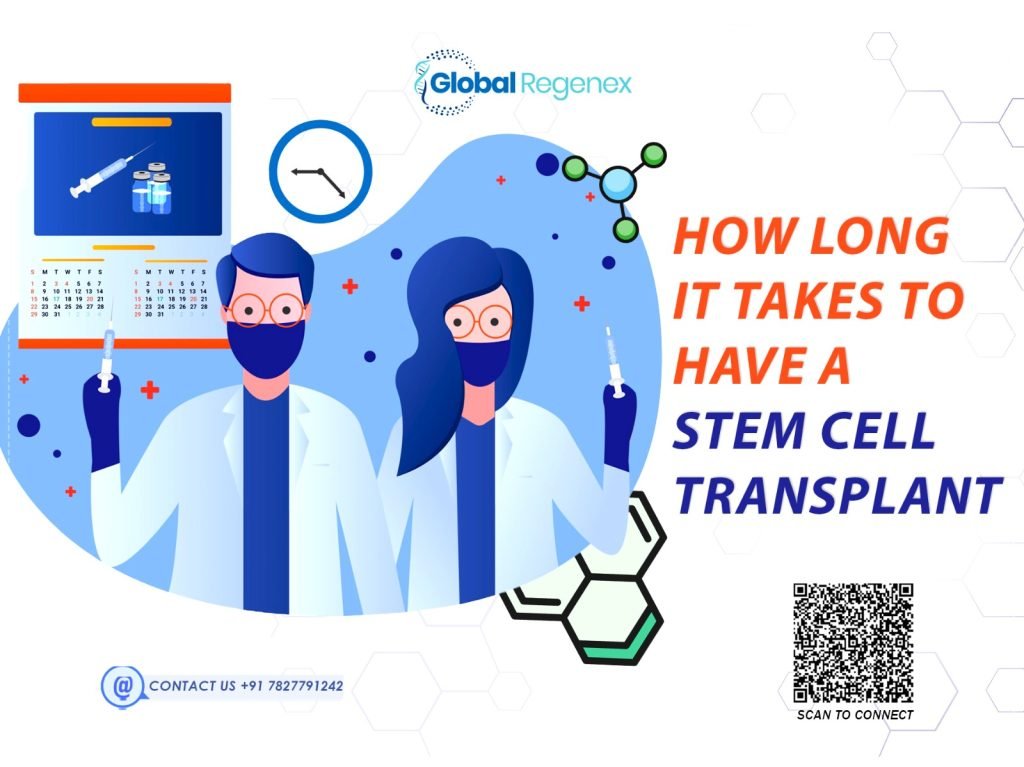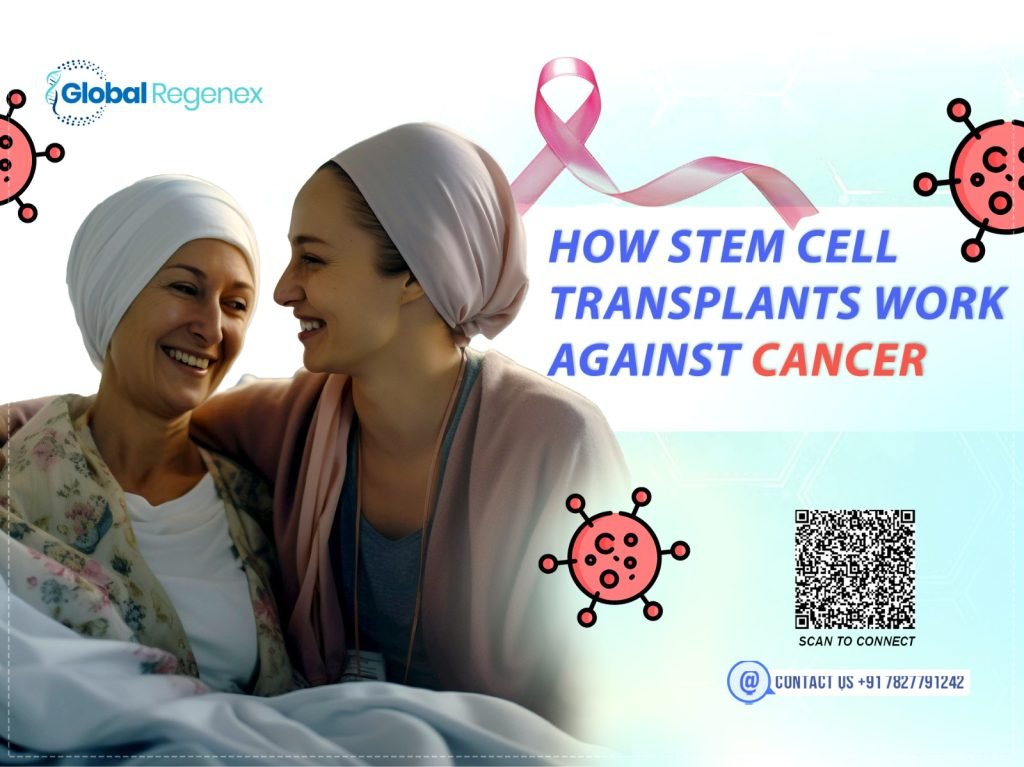How Long It Take to Have a Stem Cell Transplant?

Dealing with a degenerative condition and considering a stem cell transplant as treatment for it? This would be a great way to treat these conditions. Stem cell transplant is the process where stem cells are used to promote healing through replacing and restoring the damaged tissues or cells in the body. Now, you must be thinking about how long a stem cell transplant takes to work properly. It is helpful to understand the full process of stem cell transplant in India, whether it is for yourself or someone you love. In this blog, let’s break it down in a simple word so you know what exactly to expect. What is a Stem Cell Transplant? Stem cell transplant uses stem cells, which are interestingly renowned for their ability to differentiate into several types of cells within the body. These cells are a remarkable alternative for treating many diseases as they promote healing through replacement and regenerate damaged cells in the body with healthy ones. By healing the damaged tissues, it minimizes the inflammation in the damaged area. Benefits of Stem Cell Transplant Here are some benefits of stem cell transplant listed below: Secures Highgate: Stem cells possess remarkable potential to significantly quicken the process of healing for the body, particularly in orthopedic trauma to ligaments, tendon rupture, and cartilage injury. Decrease Pain and Inflammation: By modulating the immune system, stem cell therapy can reduce chronic pain and swelling, alleviating conditions such as arthritis and autoimmune disorders. Less Invasive: The majority of stem cell therapies are non-invasive or minimally invasive, creating shorter recovery times and less danger. Supports Natural Reconstitution: Unlike traditional treatment that merely suppresses the symptom, stem cell therapy performs better by activating the body towards restoring damaged tissue naturally. Reduced Medication Use: In body function repair, stem cell therapy decreases reliance on medication for pain and chronic medication. Therapeutic Value: As stem cells are harvested from one’s own body, there is no risk of rejection, hence, more effective and personalized therapies are obtained. Understand the Timeline for Stem Cell Transplant Although the whole process of transplant might take only one day, the full process from preparation to transplant can take a few weeks. Here is the procedure in detail: Evaluation & Preparation (1-2 days) Before undergoing the stem cell transplant, patient is require to carry out some tests to asses their health by doctors to ensure they are a perfect fit for the procedure. These evaluations might include blood tests, imaging, and sometimes biopsy. Once cleared, the patient will now begin a conditioning regimen to prepare their body. Conditioning Treatment (5-10 days) For conditioning, the patient’s body involves chemotherapy, radiation, or a combination of both to remove unhealthy cells and make space for the new stem cells. This phase is important as it helps reduce the risk of transplant rejection and promote the right environment for new cells to grow. Stem Cell Collection and Infusion (1-2 days) If the patient is receiving an autologous transplant, the stem cells are collected from their own body. In allogeneic transplants, they’re collected from a donor. The actual stem cell infusion is very quick and painless and feels a lot like having a blood transfusion and should only take a few hours. Engraftment and Monitoring (2–4 Weeks) This is when the new stem cells in the blood begin to produce healthy blood cells. Patients are closely watched at this time for infection, complication, or graft-versus-host disease. Regular blood checks are also done to watch for progress. Early Recovery and Follow-Up (1–3 Months) After you’re discharged, follow-up is routine. You’ll need to take medications, protect yourself against infections, and adopt a healthy lifestyle to help your body settle in. Your immune system is down for a while, and hence, you must be cautious even after going home. For Consultation Seeking the advice of an expert would be an excellent choice if you are thinking about undergoing treatment with stem cell therapy but would like to ask questions regarding the procedures, possible advantages, or being a candidate for treatment. Asking Global Regenex experts for advice can inform you more about the optimal health and medical considerations for your unique situation. Experienced professionals in their field can guide you through this experience to ensure you receive the best assistance available. The Concluding Thoughts Although the actual infusion of stem cells can be completed in just one day, the entire process for doing stem cell treatment in India might take several weeks or even months. Evaluations and conditioning are followed up by recovery and then monitoring. Each procedure contributes to the success of stem cell therapy in Delhi or other places. Provided with proper care and direction, most patients have life-changing outcomes.
How Stem Cell Transplants Work Against Cancer?

No one wants to take on cancer, and with modern medicine, we can only hope it makes more strides. stem cell transplants and they’re fighting cancer. If you or a loved one is fighting this disease, you’ve likely heard of stem cell therapy as a possible avenue of treatment. But how does that even work, exactly? And what is the reason for the limelight around stem cell therapy in India? Let’s simplify this and break it down. Before we continue, if you want to know what experts say about stem cell therapy or want to undertake the treatment, consult with Global Regenex for further information. What Are Stem Cells? Stem cells are repairmen of your body, they are the raw materials of body cells, which give rise to the other forms of cells. They possess the ability to become any form of damaged tissue or cells in order to heal the injured part. Stem cells can be converted into nerve cells, blood cells, and so on, with such flexibility makes them an asset in regenerative medicine. Types of Stem Cell Transplants Stem cell transplants exist in two common types: Autologous Transplant: In this kind, the patient’s own stem cells are harvested prior to chemotherapy or radiation and then returned to the body afterward. This approach lowers the risk of rejection because the cells originate from the patient. Allogeneic Transplant: In this method stem cells are taken from a donor, usually a sibling or a matched unrelated donor. Although this approach is associated with a greater risk for complications, it also creates the possibility that the donor’s immune cells will attack any leftover cancer cells. How Does Stem Cell Transplant Fight Cancer? Stem cell transplants are commonly used to restore the body’s ability to produce healthy blood cells following high-dose chemotherapy or radiation for cancer. Here’s how it works: Destroying Cancer Cells: Cancer cells are destroyed with high-dose chemotherapy or radiation. But the process also destroys healthy cells, especially in the bone marrow, where blood cells are made. Replacing Damaged Cells: Once the cancer cells have been eradicated, stem cells are then transplanted into the patient’s body. These stem cells may be harvested from the patient (autologous transplant) or from a donor (allogeneic transplant). Rebuilding the Immune System: The transplanted stem cells move to the bone marrow and begin making new, healthy blood cells. That is critical for recovery and helps rebuild the immune system. Killing Remaining Cancer Cells: Especially with allogeneic transplants, the immune cells of the donor then can recognize and attack any remaining cancer cells, adding another layer of defense. The Life-Changing Potential of Stem Cell Therapy Stem cell treatment gave new hope to cancer victims who did not improve with regular treatment. They not only assist in reconstructing the immune system but also can directly target and destroy cancer cells more efficiently. For Consultation If you are overwhelmed with the choices, you can contact Global Regenex for stem cell treatment or consultation. They have expertise in offering patients stem cell therapy as treatment worldwide, with having associations with numerous well-known hospitals. They can guide you through the process, answer your questions, and schedule an appropriate treatment plan for your needs. The Bottom Line Stem cell treatment is a ray of hope for numerous patients for cancer therapies as they can be overwhelming. If you are considering stem cell treatment in Delhi for yourself or your loved one, you need to conduct an inquiry with professionals such as Global Regenex to understand the optimal time & mode of treatment. Interested in learning more? Call us at Global Regenex for a complimentary professional consultation and personalized treatment plan.
